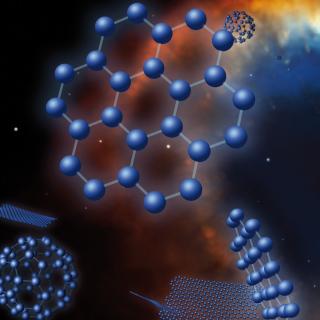Bibcode
Szigeti, L.; Mészáros, Szabolcs; Smith, Verne V.; Cunha, Katia; Lagarde, Nadège; Charbonnel, Corinne; García-Hernández, D. A.; Shetrone, Matthew; Pinsonneault, Marc; Allende Prieto, C.; Fernández-Trincado, J. G.; Kovács, József; Villanova, Sandro
Bibliographical reference
Monthly Notices of the Royal Astronomical Society, Volume 474, Issue 4, p.4810-4817
Advertised on:
3
2018
Citations
17
Refereed citations
16
Description
Carbon isotope ratios, along with carbon and nitrogen abundances, are
derived in a sample of 11 red-giant members of one of the most
metal-rich clusters in the Milky Way, NGC 6791. The selected red-giants
have a mean metallicity and standard deviation of [Fe/H] = +0.39
± 0.06 (Cunha et al. 2015). We used high-resolution H-band
spectra obtained by the SDSS-IV Apache Point Observatory Galactic
Evolution Experiment. The advantage of using high-resolution spectra in
the H band is that lines of CO are well represented and their line
profiles are sensitive to the variation of
12C/13C. Values of the
12C/13C ratio were obtained from a spectrum
synthesis analysis. The derived 12C/13C ratios
varied between 6.3 and 10.6 in NGC 6791, in agreement with the final
isotopic ratios from thermohaline-induced mixing models. The ratios
derived here are combined with those obtained for more metal poor
red-giants from the literature to examine the correlation between
12C/13C, mass, metallicity, and evolutionary
status.
Related projects

Nucleosynthesis and molecular processes in the late stages of Stellar Evolution
Low- to intermediate-mass (M < 8 solar masses, Ms) stars represent the majority of stars in the Cosmos. They finish their lives on the Asymptotic Giant Branch (AGB) - just before they form planetary nebulae (PNe) - where they experience complex nucleosynthetic and molecular processes. AGB stars are important contributors to the enrichment of the
Domingo Aníbal
García Hernández

Chemical Abundances in Stars
Stellar spectroscopy allows us to determine the properties and chemical compositions of stars. From this information for stars of different ages in the Milky Way, it is possible to reconstruct the chemical evolution of the Galaxy, as well as the origin of the elements heavier than boron, created mainly in stellar interiors. It is also possible to
Carlos
Allende Prieto